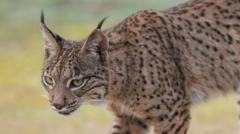During a mating call captured by a camera trap, Navarro, a striking male Iberian lynx, showcases the beauty of this elusive feline, known for its distinctive leopard-like spots. Measuring nearly 100 cm long and standing 45 cm tall, sightings of the Iberian lynx, once a rare occurrence, are now much more common in the wilds of Spain and Portugal, where the population has surged to over 2,000 since the low point of fewer than 100 individuals two decades ago.
Rodrigo Serra, who oversees the lynx reproduction programs in both countries, reflects on the species' perilous history. "The Iberian lynx was very, very close to extinction," he notes, emphasizing that only 25 of the remaining lynxes were female and capable of reproduction. Once relegated to the fate of creatures like the saber-toothed tiger, the lynx has managed to claw its way back.
A combination of factors had led to their decline, including habitat loss from agriculture, vehicle collisions, and a scarcity of their primary prey—wild rabbits. Two pandemics decimated the rabbit population by 95%, jeopardizing the lynx's survival. In 2005, Portugal had no lynxes left, but a pivotal shift occurred when Spain celebrated the first captivity birth of the lynx, prompting Portugal to establish a national conservation action plan shortly thereafter. The National Breeding Centre for Iberian lynxes in Silves, Algarve, was born out of this commitment, where the lynxes are carefully monitored and prepared for eventual release back into the wild.
Serra explains delicate training techniques used at the center: "When we notice a litter is becoming a bit more confident, we go in and chase them and make noise so they are scared again and climb the fences." This method ensures future wild lynxes maintain their natural instincts and stay away from humans, thus being equipped for survival.
Selection for reintroduction is based on genetic diversity to prevent inbreeding, and even lynxes born in Portugal may be sent to Spain. Pedro Sarmento, a biologist and lynx specialist for 30 years, underscores the animal's unique physical traits, highlighting its small head relative to its body and its unusually large paws, which provide exceptional jumping abilities.
While the breeding program has been successful, its expansion has introduced some challenges, particularly concerning local agriculture. Agreements with landowners are essential, and although there have been occasional incidents with poultry, a strategic approach, including fortifying coops and monitoring movements, is helping to mitigate conflicts.
The journey of the lynx named Lítio represents both the potential and unpredictability of reintroduction efforts. After being released into Portugal, it traveled to Doñana National Park in Spain, where it was later treated for illness and returned to the breeding center. Lítio's spirit of return culminated in his final release when he stationed himself near a female lynx, subsequently fathering multiple cubs.
Today, over 30 years after targeted conservation began, the Iberian lynx is no longer classified as endangered. The objective going forward is to stabilize the wild population at 5,000 to 6,000 by 2035, further solidifying their comeback. "It’s surreal that we’re in a place where we can see lynxes in nature or through camera trapping almost daily," Serra expresses, reflecting on the fleeting moments when these creatures were on the path to vanishing. However, risks such as road fatalities remain prevalent, with 80% of lynx deaths recorded last year attributed to traffic accidents. Despite these challenges, hope abounds as conservationists continue their tireless work to secure a future for the Iberian lynx.




















